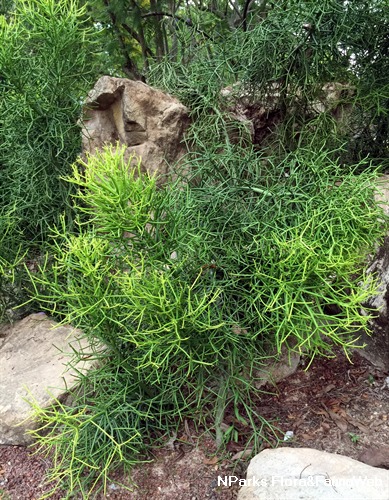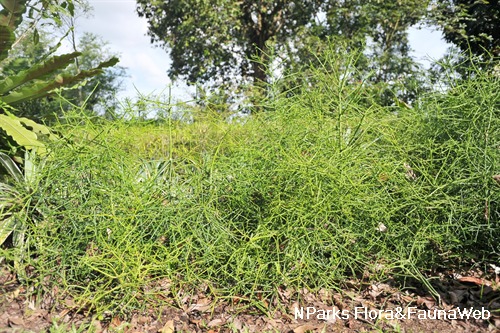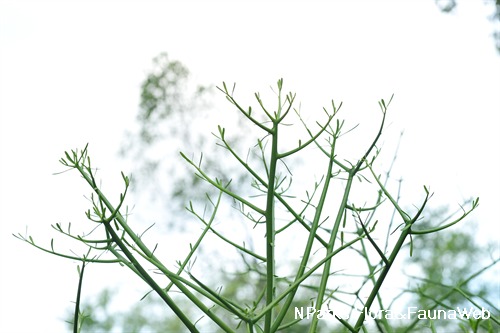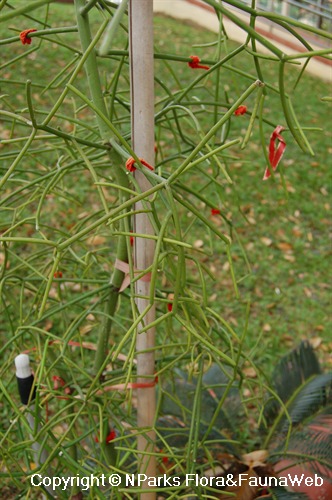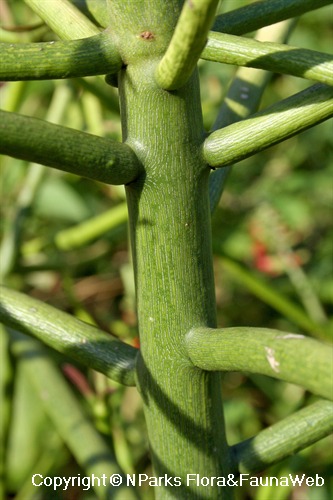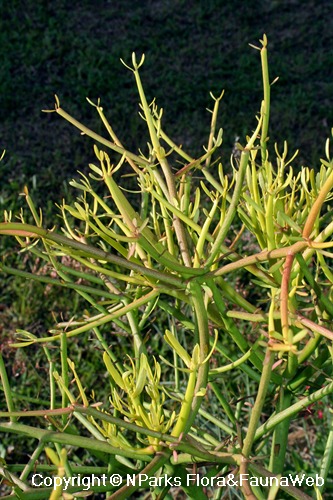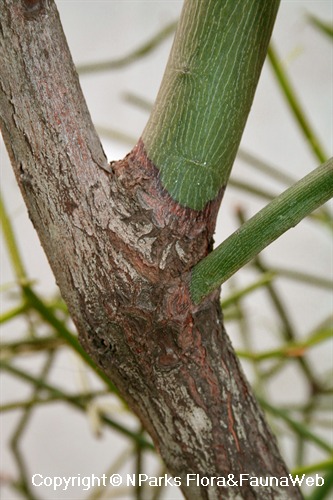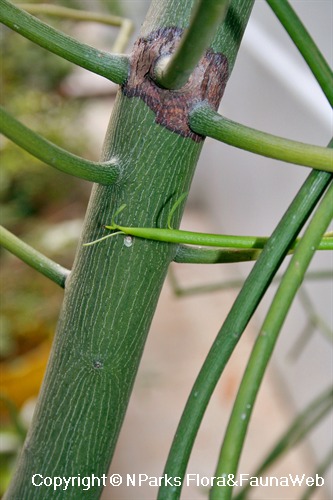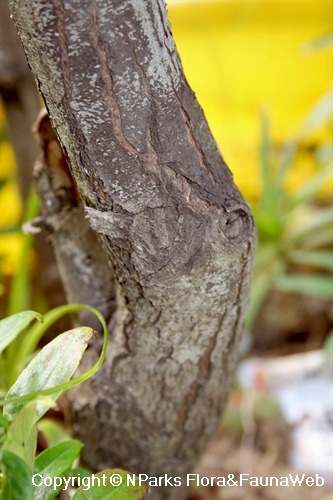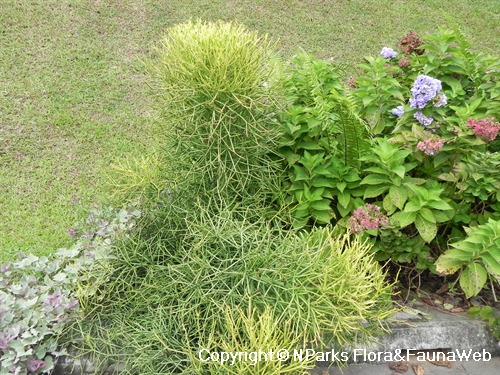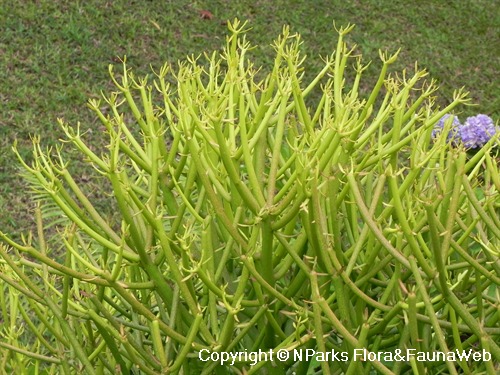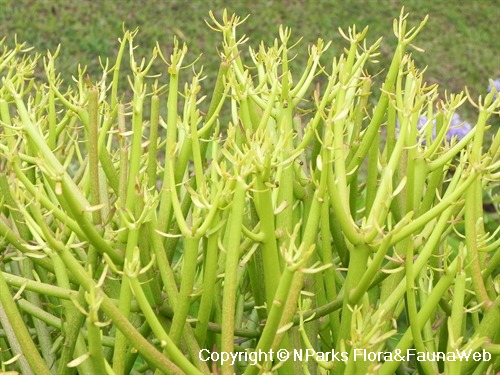
Back
Euphorbia tirucalli L.
| Family Name: | Euphorbiaceae |
| Synonyms: | Euphorbia rhipsaloides, Acalypha indica |
| Common Name: | African Milkbush, Finger Tree, Caustic Bush, Pencil Euphorbia, Pencil Tree, Milk Hedge, Petroleum Plant, Milk Bush, Tentulang, Tulang-Tulang, 绿玉树, 綠珊瑚 |
Name
Classifications and Characteristics
| Plant Division | Angiosperms (Flowering Seed Plants) (Dicotyledon) |
|---|---|
| Plant Growth Form | Shrub |
| Lifespan (in Singapore) | Perennial |
| Mode of Nutrition | Autotrophic |
| Maximum Height | 3 m to 9 m |
| Maximum Plant Spread / Crown Width | 2 m to 3 m |
Biogeography
| Native Distribution | East Africa to South Africa, India |
|---|---|
| Native Habitat | Terrestrial |
| Preferred Climate Zone | Sub-Tropical / Monsoonal, Desert / Arid |
| Local Conservation Status | Non-native (Horticultural / Cultivated Only) |
| CITES Protection | True (Appendix II) |
Description and Ethnobotany
| Growth Form | Succulent tree with a highly branched growth form, usually up to 3-5 m tall, but sometimes up to 10 m tall. |
|---|---|
| Foliage | Oblanceolate leaves (=lance-shaped but wider near the tip) drop off soon after they are produced (1-2.5 cm long, 3-4 mm wide). |
| Fruit | Dry, dehiscent fruits are known as capsules which are small and round. |
| Associated Fauna | In South Africa, crested guinea-fowl, francolins and Velvet monkeys consume the fruits, while black rhinos eat the branches. |
| Cultivation | Avoid skin or eye contact with the milky latex which can cause welts or temporary blindness. |
| Ethnobotanical Uses | Medicinal: Small doses of latex traditionally used to treat warts, asthma, rheumatism, syphilis and various other ailments. In Java, latex is also rubbed over skin to treat bone fractures. Pounded stems used as poultice to relieve swellings and remove embedded thorns. Roots used as antidote for snakebites, and root infusions used to relieve aching bones. Latex mistakenly believed by some in Africa to be a cure for male sterility, and attempted ingestions resulted in serious consequences, including death. Also regarded as folk remedy for cancers and tumours, but this is questionable, especially since it is implicated as a co-factor in Burkitt's lymphoma. Timber & Products: Wood is white and borer-resistant, as well as stronger than that of other Euphorbia species, but not normally utilized other than to make rafters, veneers and toys. Agriculture - Forestry: In Sri Lanka, this species is planted as a hedge between paddy fields. Others: Plant regarded as "fish poison" tree due to milky latex -- macerated branches are placed in streams to stun fishes and make them easier to capture. Toxic latex also used as rat poison. Thought to be a mosquito repellent and planted for this purpose in Africa. Also planted as thicket-like hedges around houses to keep out wildlife and livestock. Once thought to be a possible source of rubber, but the high-resin latex is of too poor quality for rubber production. The rubber is added to a paint applied to the bottom surface of boats to prevent them from being colonized by marine creatures. |
Landscaping Features
| Desirable Plant Features | Ornamental Stems |
|---|---|
| Landscape Uses | Container Planting, Coastal, Hedge / Screening, Focal Plant, Swimming Poolside, General |
| Thematic Landscaping | Rockery / Desert Garden |
| Usage Hazard - Cons | Irritant - Sap, Toxic Upon Ingestion, Irritant - Contact Allergy |
Fauna, Pollination and Dispersal
| Pollination Method(s) | Biotic (Fauna) (Insects (Bee), Insects (Butterfly, Moth), Insects (Ant, Beetle, Fly, Thrip, Wasp), Vertebrates (Bird)) |
|---|
Plant Care and Propagation
| Light Preference | Full Sun |
|---|---|
| Water Preference | Little Water |
| Rootzone Tolerance | Saline Soils / Salt Spray, Drought Tolerant, Poor Infertile Soils |
Foliar
| Foliage Retention | Deciduous |
|---|---|
| Mature Foliage Colour(s) | Green |
| Foliar Modification | Reduced / Needle-like |
| Foliar Type | Simple / Unifoliate |
| Foliar Arrangement Along Stem | Alternate |
| Foliar Attachment to Stem | Sessile |
| Foliar Shape(s) | Non-Palm Foliage (Oblanceolate) |
| Foliar Apex - Tip | Acute |
| Foliar Base | Cuneate |
| Typical Foliar Area | Nanophyll ( 0.25cm2 - 2.25 cm2 ) |
| Leaf Area Index (LAI) for Green Plot Ratio | 4.5 (Shrub & Groundcover - Dicot) |
Non - Foliar and Storage
| Stem Type & Modification | Herbaceous |
|---|---|
| Root Type | Underground (Fibrous Root) |
| Specialised Storage Organ(s) | Aboveground |
Floral (Angiosperm)
| Flower & Plant Sexuality | Unisexual Flowers |
| Flower Colour(s) | Yellow / Golden |
|---|---|
| Flower Grouping | Cluster / Inflorescence |
| Flower Location | Terminal |
| Flowering Habit | Polycarpic |
Fruit, Seed and Spore
| Fruit Classification | Simple Fruit |
|---|---|
| Fruit Type | Dehiscent Dry Fruit , Capsule |
Image Repository
Others
| Master ID | 713 |
|---|---|
| Species ID | 2008 |
| Flora Disclaimer | The information in this website has been compiled from reliable sources, such as reference works on medicinal plants. It is not a substitute for medical advice or treatment and NParks does not purport to provide any medical advice. Readers should always consult his/her physician before using or consuming a plant for medicinal purposes. |

